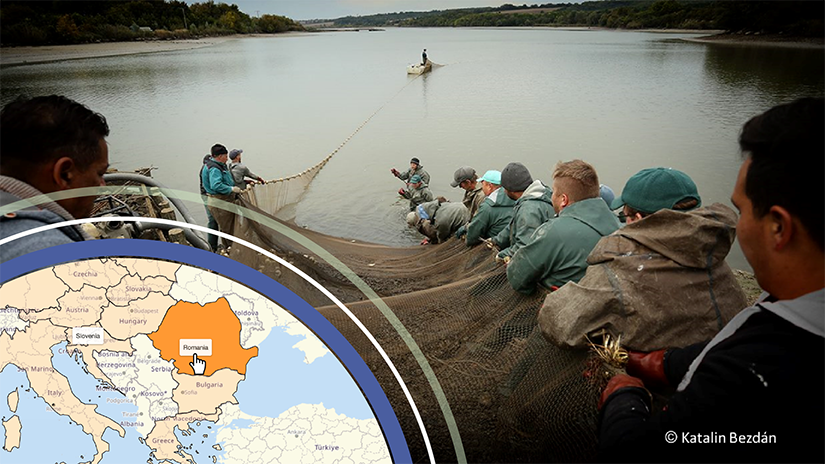Background information

Type of species farmed
Common carp (Cyprinus carpio), bighead carp (Hypophthalmichthys nobilis), silver carp (H. molitrix), trout (different species), goldfish (Carassius auratus), sturgeon (different species).
Source: 2024, STECF
Type of production method
According to Eurostat, the aquaculture activity in Romania is limited to freshwater farming. Production consists in its entirety in pond.
Source: 2025, EUMOFA
Sector’s size (production and consumption)
Source: 2024, STECF & EUMOFA
Trends (past and future)
Recently, extensive fish farms have become multifunctional, providing services such as ecological tourism, recreational fishing, and educational activities related to knowledge about and protection of aquatic biodiversity. There is a trend to diversify and increase the current range of aquaculture activities.
Source: EuroFish
Impact of aquaculture in the country’s economy, food market and labour market
- The growth in aquaculture production can be attributed to the expanded production of common carp in polyculture, extensively or semi-intensively.
- The production of species new to Romanian aquaculture, such as sturgeon, is still low.
- Salmonicultura is the sector constantly growing. At present, the salmonicole establishments in Romania have as their main objects the following species: rainbow trout (Oncorhynchus mykiss), brown trout (Salvelinus fontinalis) and indigenous trout (Salmo trutta fario).
- Marine aquaculture has a relatively recent development in the Black Sea and particularly on the Romanian coast.
- From the point of view of distribution by development region, in 2019 it is noted that the largest share of production achieved is represented by the North-East development region with 29 % of the total national production, followed by the development regions of South, South-East, North-West and Centre with a share of between 9 and 21 %. The very small share of production in the South-West and Bucharest-Ilfov regions is due to most of the fishing facilities are mainly recreational farmers.
- The consumption of fisheries and aquaculture products is far below the EU average. Romanian’s household consumption is dominated by live/fresh fish, followed by frozen fish, and marinated and prepared products. The top four preferred species are trout, carp, mackerel, and salmon.
Source: MNSPA
Challenges and opportunities
- Predation by wild birds and animals is a big problem.
- Legislative instability, lack of unified approach and unjustified administrative barriers.
- Unclear legal regime of the land on which aquaculture farms are located.
- Lack of a general land register in Romania.
- Other external constraints include climate change, a perceived lack of innovation, and inefficient collaboration between farmers and science.
- Romanian offshore mariculture is conditional on the development of marine equipment to withstand the hydrometeorological conditions specific to the Black Sea. The main limiting factors identified are the lack of sheltered areas, storms and low winter temperatures, which may jeopardise production.
- Lack of labour force.
- Restrictions on the application of environmental regulations: May lead to a loss of fisheries and income and ultimately to their abandonment.
- Access limited to credit schemes dedicated to aquaculture production with lengthy procedures for their approval.
- Pathological status, epizootic diseases.
- The country’s land resources and availability of inland waters provide excellent conditions for fish farming.
- New species into aquaculture is proposed to take place in intensive, closed, recirculating farming systems that reduce the possibility of these species escaping into the natural environment. However, cyprinid farming in polyculture is the type of integrated multi-trophic aquaculture which, in terms of environmental objectives, has the advantage of preserving or improving water quality and contributing, through nutrient recycling, to the circular economy as a net provider of environmental services to society.
- There is a desire for regional development from a scientific and technological point of view in marine aquaculture.
- Increased accessibility to renewable energy technologies.
- Whether it is possible to provide feed requirements for cipriniculture from internal resources.
- Potential for tourism, recreational fishing and other activities complementary to aquaculture.
- Production of granulated feed in Romania.
- Availability of technology for implementing process digitalization.
- Financial instruments.
(Source: EuroFish & MNSPA)
Employment and number of enterprises
504 enterprises and 2231 employees in 2018.
Source: EuroFish
Multi-annual National Strategic Plans for the development of sustainable Aquaculture
Relevant Authorities
Applicable Legislation
- Law No. 192 “On living aquatic resources, fisheries and aquaculture”
- Government Emergency Order No 23/2008 on fisheries and aquaculture (as completed and amended by Law No 317/2009)
- ORDER no. 332 / 2008 regarding the registration of aquaculture production units in the Register of aquaculture units and the issuance of the aquaculture license
Applicable Procedures
- Aquaculture licence
- Register of aquaculture establishments
National associations and networks
Relevant Websites
- Danube Delta National Institute for Research and Development
- Danube Delta Biosphere Reserve Authority
- The Fish Culture Research and Development Station
- National Institute for Marine Research and Development “Grigore Antipa”
- Research and Development Institute for Aquatic Ecology, Fisheries and Aquacultu…
Contact Details
National Agency for Fisheries and Aquaculture
Alexandru Gheorghe, Counsellor
- Telephone number: 0374 466 140
